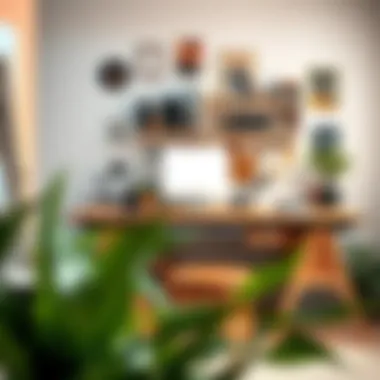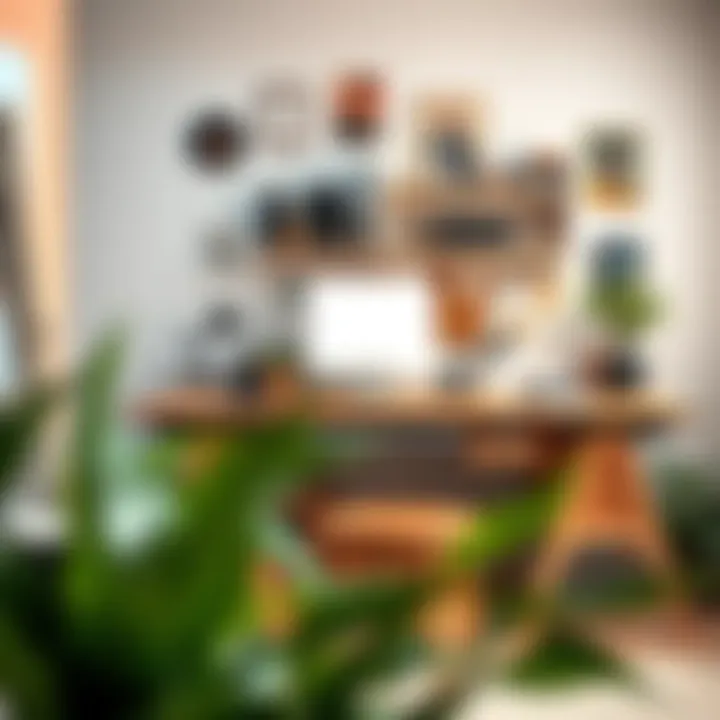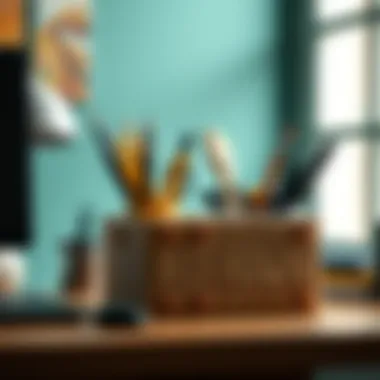Art Supply Desk Organizers: A Complete Guide


Intro
In the dynamic space of creativity, having an organized area can significantly streamline the artistic process. For many, the clutter of art supplies can become an obstacle rather than a source of inspiration. Art supply desk organizers are more than just storage solutions; they embody the balance between functionality and aesthetics. As we dive into the world of these organizers, we will explore the intricate relationship between design and practicality, and how a well-organized workspace can elevate creativity and efficiency.
Art supply desk organizers come in various styles, materials, and functionalities. They are crafted not only to house your brushes, paints, and sketchbooks but to create an environment that fosters productivity. This guide serves to illuminate diverse designs, essential materials, and the psychological benefits of an orderly workspace. Join us as we traverse through the popular types of organizers, discover tips for selecting the right fit for your needs, and even explore some DIY tips for the more crafty souls among us.
An organized environment naturally reduces stress and chaos, allowing an artist's mind to flourish. Whether you’re a homeowner looking to enhance your craft area, a designer seeking inspiration, or a DIY enthusiast eager to create your custom storage solution, this guide offers practical advice tailored to your unique journey. Let's jump into the details and demystify the issues surrounding art supply desk organization.
Understanding Art Supply Desk Organizers
Art supply desk organizers play a crucial role in establishing a functional workspace for creators. An artist’s environment can be as important as the tools they use, and a well-organized desk fosters creativity and efficiency. In this section, we will explore the definitions, purposes, and historical contexts surrounding art supply organizers, providing a comprehensive overview of their significance in the creative process.
Definition and Purpose
An art supply desk organizer is designed to assist artists, designers, and DIY enthusiasts in managing their various materials—be it paints, brushes, pens, or papers. These organizers vary widely in design, from simple containers to complex modular systems. They can be made from different materials such as wood, plastic, and metal, catering to diverse aesthetic preferences and functional demands.
The main purpose of these organizers is to eliminate clutter. Having all materials easily accessible not only saves time but also allows for a more seamless flow in the creative process. Imagine diving into a painting session and not being able to find the right brush; it’s a frustration that can hinder inspiration. With a dedicated organizer, everything is in its place. This enhances not just practicality but also keeps the workspace visually appealing, conducive to creativity.
Historical Context
The journey of art supply desk organizers dates back to the days when artists used to create in their attics or dedicated rooms, lacking the organized spaces we see today. Early artists relied on makeshift solutions, such as old boxes or wooden crates, to store their instruments. Over time, as art evolved and became more accessible, so did the necessity for efficient storage.
The invention of materials like plastic and innovations in design has led to a surge in available organizers, bringing customization into the hands of artists. No longer are these tools a luxury; they've become an integral part of an artist's kit. Organizations started marketing products suited to artists—a trend that continues to gain momentum. With the rise of DIY culture, many individuals now create their own organizing solutions, merging functionality with personal flair.
Such historical shifts underline the importance of having a dedicated system for organizing art supplies. They highlight how methods of storage and organization have paralleled advancements in artistic techniques and practices.
"An organized space is the canvas for the creativity that unfolds."
The discussion about art supply desk organizers is not just about what they look like or how they function; it's about creating the right environment to inspire creativity and streamline productivity. As we delve deeper into the types of organizers and the materials they're made of, it will become evident how essential these tools are in an artist’s journey.
The Importance of Organization
In the realm of creativity and artistry, organization plays a pivotal role in unlocking potential. It's not merely about aesthetics or tidiness; it influences how artists interact with their materials, impacts their workflows, and ultimately shapes the quality of their output. A well-organized workspace can streamline processes, foster innovation, and enhance the overall creative experience. Here are some critical elements to consider in the importance of organization:
- Mental Clarity: A clutter-free environment reduces visual distractions. When supplies are arranged logically, artists can focus better on their craft, leading to enhanced mental clarity.
- Time Efficiency: Searching for lost supplies can eat away at valuable creative time. A systematic arrangement means that everything is within arm's reach, optimizing the time spent on actual creation.
- Creativity Boost: Surprisingly, organization can amplify creativity. When the workspace is tidy, it encourages risk-taking and experimentation, as there’s less fear that a chaotic environment will hinder the outcome.
One can see the immediate benefits of organization reflected in the increased output and the quality of work produced. Consider, if you will, the scenario of an artist trying to start a painting amidst a flurry of scattered brushes and half-opened paints. That sense of overwhelm stifles inspiration.
Enhancing Creative Flow
The creative process often resembles a river, flowing with ideas, intuition, and exploration. Just as a river with obstacles can become stagnant or diverted, a cluttered workspace can disrupt this flow. An organized setting enables creativity to flourish by providing:
- Ease of Access: When brushes, canvases, and paints are well-organized, artists spend less time hunting down materials and more time engaging with the creative flow.
- Improved Focus: A clear workspace allows for a clear mind. With fewer distractions from misplaced items or overflowing supplies, artists can delve deeper into their projects.
- Freedom to Experiment: With everything in its place, there’s a comfort that encourages experimentation, whether trying out new techniques or combining different media together.
"An organized space is the stage on which creativity performs its grandest show."
Impact on Productivity
Being organized is not just about personal preference; it can have a profound impact on productivity. Organization strategies can allow artists to maximize their effort while minimizing wasted time. Key points include:
- Task Prioritization: A structured space lends itself to planning. Artists can prioritize tasks, ensuring that they meet deadlines and maintain a steady rhythm in their work.
- Resource Management: The right setup helps in managing resources efficiently. From ensuring supplies are stocked to knowing when something needs replacement, an organized workspace can significantly reduce bottlenecks in the creative process.
- Motivation to Create: Often, disorganization can lead to feelings of frustration or lethargy. A tidy space can serve as a motivational tool, encouraging not just action but enthusiasm in tackling new projects.
In summary, the importance of organization transcends a mere preference for tidiness. It is a powerful influence on creative expression and productivity, making it an essential aspect for any artist or creative practioner looking to enhance their workspace.
Types of Art Supply Desk Organizers
Art supply desk organizers come in a multitude of shapes and forms, each tailored to cater to different needs and preferences. Understanding the various types available is crucial for anyone looking to maintain a clutter-free and efficient workspace. This section will explore the main categories of organizers: desktop, drawer, wall-mounted, and portable solutions. Each type presents unique benefits that can significantly enhance your creative process.
Desktop Organizers
Desktop organizers are perhaps the most familiar and widely-used type. They sit on your desk, offering easy access to art supplies like brushes, pencils, and paints. A well-designed desktop organizer can transform the chaos of scattered materials into an orderly paradise.
These organizers often come in various styles, from simple trays to multi-tiered racks. In choosing one, it's wise to consider how you operate. For instance, if you reach for specific tools frequently, an open organizer with compartments can provide quick access.
"When everything is in its right place, your mind can be too."
They often feature different sections for items of varying sizes, ensuring that even your largest easels or smallest nibs have dedicated spaces. This not only reduces the time spent searching for supplies but also enhances the overall aesthetic of your workspace, making it visually pleasing.
Drawer Organizers
Moving deeper into organization, drawer organizers serve a unique purpose by neatly arranging items within the confines of your desk drawers. These organizers maximize storage efficiency, making it easier to store bulkier items that may otherwise clutter your desktop.


When selecting a drawer organizer, consider factors such as depth and width of your drawers as well as the type of materials you typically use. Different organizers feature varying configurations, with dividers, trays, and compartments customized for specific art supplies. This dimensional versatility allows you to customize your storage space to fit your artistic process.
They also help in preserving your art materials, shielding them from dust or accidental breakage. Having a clear layout within drawers encourages regular organization, keeping forgotten supplies in plain view.
Wall-Mounted Solutions
For those with limited desk space, wall-mounted organizers can be a game changer. These systems make use of vertical space, allowing you to position tools, paints, and papers conveniently where you can see them. By going vertical, you not only save desk area but also create a dynamic, inspiring display of your materials.
Wall-mounted organizers come in many forms, from pegboards to shelves, all designed to adapt to various artistic needs. Moreover, these systems can be customized; hooks can hold scissors and brushes while shelves can offer a home for cans of paint and sketchbooks.
Such organizers also contribute to an artistic ambiance, turning your workspace into a vibrant part of your decor. Think of them as both functional tools and visual inspirations.
Portable Organizers
Lastly, portable organizers are ideal for artists who may need to transport their supplies frequently. These versatile options come in compact cases or bags that keep everything from paints to sketch pads contained and organized during travel.
When selecting a portable option, you'll want to focus on durability. Many today are made from weather-resistant materials, ensuring that your supplies remain protected, no matter where inspiration strikes.
Some key features to look for include adjustable compartments, sturdy handles, and zippers that can withstand wear and tear. Besides, a well-organized portable case can help mitigate the usual travel chaos, ensuring you're ready to create masterpieces wherever you go.
In sum, understanding the variety of art supply desk organizers is essential for establishing an environment that enhances creativity. Each type serves specific needs, and choosing the right one can lead to a more inspiring and productive workspace.
Materials Used in Art Supply Desk Organizers
Art supply desk organizers can greatly impact both the functionality and aesthetics of a creative workspace. Understanding the materials used in these organizers is essential for making an informed choice that aligns with both practical needs and personal style. Each material brings distinct qualities and benefits that cater to various requirements. Let’s delve into the different types of materials that are commonly used in constructing these organizers, examining their features, advantages, and considerations.
Wood and Bamboo
Wood has long been a favored material for art supply desk organizers. It offers a timeless appeal, adding warmth and character to any workspace. Whether it's oak, maple, or cherry, wooden organizers are not just durable; they are also environmentally friendly, particularly when sourced sustainably.
Bamboo, in particular, has gained traction in recent years. This fast-growing grass is sturdy and lightweight, making it a practical choice. Furthermore, the natural texture of bamboo can complement a variety of design schemes, wrapping your workspace in a calm, inviting feel. However, wood can be prone to scratches and may require regular maintenance to keep it looking new.
Metal and Wireframes
Metal organizers, often crafted from aluminum or steel, are robust options designed to endure everyday wear and tear in busy artistic environments. The industrial aesthetic they provide can suit modern or minimalist tastes well.
Wireframes, often utilizing metal as well, allow for clearer visibility of tools and supplies. These designs can make it easy to find what you need at a glance. Metal organizers are also easy to clean, though one should be aware that they may not offer the same level of protection against corrosion if exposed to moisture consistently.
Plastic and Acrylic
Plastic and acrylic materials have emerged as versatile options for art supply desk organizers. They come in a variety of colors, shapes, and designs, offering a fun and creative twist to organization. One of the most significant advantages of plastic is its lightweight nature, which aids in mobility, particularly for artists who may like to rearrange their spaces frequently.
Acrylic, on the other hand, provides a sleek, modern look. Its clear nature allows for visibility of contents while keeping them protected. However, in environments that may experience heavy use, the scratch resistance of plastic can be a concern, requiring careful handling to maintain clarity and appearance.
Upcycled Materials
In today's eco-conscious world, upcycled materials are gaining popularity and quite rightly so. From old wooden crates to repurposed metal containers, these options promote sustainability and creativity. Art supply organizers built from upcycled materials not only tell a unique story but also provide a robust solution for storage needs.
Customizability is another advantage of these materials; they can often be modified, painted, or decorated to reflect personal aesthetic preferences. However, the quality may vary significantly. Diligence is needed to ensure that the chosen upcycled organizer is sturdy and functional enough to handle art supplies effectively.
"Choosing the right materials for your organizer can enhance the functionality and aesthetic of your workspace, making every creative endeavor a bit easier."
Choosing the Right Organizer
Choosing the right organizer is crucial for maximizing efficiency and enhancing the creative process. Art supply desk organizers come in many shapes and sizes, designed for various needs and preferences. Selecting the appropriate one can dramatically change how an artist interacts with their workspace, streamlining not just physical tools, but also mental workflow.
Assessing Needs and Space
Before you start searching high and low for the perfect organizer, it’s important to critically assess your specific needs and the space available. Start by evaluating which art supplies you use most frequently. Do you have more brushes than pens, or is your paint collection sprawling? Understanding your most-used items guides your choice. Consider the layout of your desk or work area as well. If you operate in a cozy nook, a compact organizer might be your best bet.
Here’s a handy checklist:
- Inventory your supplies
- Measure your workspace
- Think about accessibility
A well-organized drawer helps utilize every inch of your work surface, so be mindful of height and width. Incorporating vertical storage solutions for smaller spaces can also help immensely.
Budget Considerations
Now, let’s talk dollars and cents. Budget plays a pivotal role in your choice of desk organizer. While it's easy to get swept away by aspirational products from high-end brands, it's essential to keep your finances in check. Quality doesn�’t always mean higher price; you might find affordable options made from sustainable materials or unique second-hand finds that do the trick just as well.
Consider creating a rough budget by answering these questions:


- What’s the maximum amount you can comfortably spend?
- Are there any temporary solutions you can explore while saving?
- Are there seasonal sales or local markets to check out?
Prioritize quality over quantity and don’t shy away from materials that are durable yet cost-effective. Remember, a functional workspace is worth the investment!
Aesthetic Preferences
Beyond functionality and price, personal aesthetic plays a significant role in choosing an organizer. Your workspace should reflect one’s style and inspire creativity. Do you prefer clean lines and a minimalist feel, or does eclectic vintage décor spark joy?
When choosing an organizer, consider these points:
- Matching your décor: Pick colors and materials that complement the existing setup.
- Personalization options: Look for organizers that allow for creative tweaks, such as paint or embellishments.
- Mood impact: Brighter colors can inspire energy while softer tones might promote calm.
Remember, an organizer isn’t just a tool; it can contribute to a positive atmosphere. Adding a personal touch not only enhances functionality but can positively influence your creative output.
"The surroundings you create for yourself profoundly impact your ability to create. Choose wisely!"
In summary, choosing the right organizer involves a blend of practical assessments, budget planning, and personal style considerations. Taking the time to evaluate these aspects sets the stage for a more organized and productive creative journey.
DIY Art Supply Desk Organizers
Creating your own art supply desk organizer has a unique charm and personal touch that store-bought solutions often lack. DIY Art Supply Desk Organizers not only provide a sense of accomplishment but also allow for customization that reflects individual style and needs. This section delves into the significance of DIY projects in art organization, focusing on creative expression, sustainability, and functionality.
Creative Upcycling Projects
In a world where sustainability is becoming more significant, upcycling old materials into art supply organizers is a trend that is catching fire. Think about it; that old wooden crate or a few tin cans in your garage can transform into a chic and functional storage solution. Here are some ideas:
- Wooden Crates: Stack a few wooden crates to create tiered shelving for paints, brushes, and other supplies. A lick of paint can make those crates pop.
- Tin Cans: Clean and decorate tin cans for brush holders or markers. You can wrap them with twine or paint them in bright colors for fun accents.
- Old Drawers: If you've got drawers sitting around, you can mount them on walls for an artistic shelf that holds all your essentials.
Not only do these projects save money, but they also bring a creative aspect into the mix, allowing you to express your personality through repurposing items.
"One man's trash is another man's treasure." This adage perfectly reflects the beauty of upcycling; it turns the mundane into something delightful.
Custom Designs and Templates
Going the DIY route also allows for designing something truly unique tailored to your exact needs. For those who prefer a hands-on approach to creating their storage solutions, you can draw up your own plans or find templates online. Some considerations include:
- Dimensions: Measure your workspace before you start. Knowing the space helps ensure that the organizer perfectly fits your desk.
- Styles: Maybe you want a rustic feel or a more modern design. Look for inspiration on platforms such as Pinterest or Instagram to get a sense of what speaks to you.
- Functionality: Think about what supplies you need to organize. Will it be mostly pens and pencils? Or do you have a stash of paints that require a different setup? Planning meticulously at this stage can save time down the line.
To facilitate the process, you may find DIY design tools online, such as SketchUp or Canva, which can help you visualize your idea before you start building.
Building a custom organizer from scratch offers more than just utility; it embodies the essence of your creative process, connecting the tools of your art to your artistic mind. This personalized approach nurtures a sense of ownership and pride in your workspace.
The Psychological Benefits of a Clutter-Free Workspace
A clutter-free workspace doesn’t just look tidy; it can significantly impact your mental well-being and productivity. When surrounded by chaos, it’s easy to feel overwhelmed. A well-organized desk, on the other hand, can foster a sense of control and clarity. Let’s delve into how removing clutter from your workspace can provide substantial psychological benefits.
Reducing Stress and Anxiety
One of the primary psychological benefits of maintaining a neat workspace is the reduction of stress and anxiety. Picture this: you’re trying to focus on a painting, but the avalanche of supplies strewn across your desk is pulling your attention in every direction. Messy spaces can create mental noise, making it challenging to concentrate. In contrast, a clean and orderly desk allows your mind to focus on the task at hand.
Here are a few specific ways a clutter-free environment helps decrease stress:
- Visual Clarity: As humans, we often perceive the world visually. A cluttered workspace bombards the eyes with an overload of information. By keeping items organized, you reduce this sensory overload, sending a signal to your brain that it's time to concentrate.
- Enhanced Control: Clutter can give rise to feelings of being overwhelmed. Keeping your desk organized nurtures a sense of control over your surroundings, which can be a powerful antidote to anxiety. When things are in their place, you can find what you need easily, reducing frustration and allowing for smooth work flow.
- Increased Focus: Your mental energy is limited, and a cluttered space can sap away that energy. By investing time in organizing your supplies, you lighten the load on your mind, making space for creativity and focus to flourish more freely.
"A tidy desk is not just a sign of a tidy mind—it's a gateway to productivity."
Boosting Creativity
You might be surprised to learn that an orderly workspace does more than just reduce stress—it also enhances your creativity. The link between a clear space and a clear mind is well-documented. When you eliminate distractions, your brain is free to wander through the avenues of imagination without the hindrance of clutter.
Consider these points for how organization fuels creativity:
- Freedom from Distraction: A tidy workspace fosters an environment where distractions are minimized. Instead of searching for that paintbrush or sketchbook lost amidst the mess, you can dive right into your creative process, allowing ideas to flow seamlessly.
- Inspiring Environment: A clean and organized desk can feel less oppressive and more inviting. Adding personal touches, like artwork or a plant, can transform your workspace into a sanctuary for creativity. This naturally enhances your mood, encouraging you to think outside the box.
- Structured Thought Process: Creativity and organization aren’t mutually exclusive. In fact, a clear workspace can promote structured thinking, helping artists and creators visualize their projects more clearly and systematically. This sense of structure opens the door to innovative ideas.
Innovative Storage Solutions for Artists
The art world thrives on creativity, and so too should the environments where that creativity is nurtured. In this context, innovative storage solutions are not merely practical; they play a vital role in empowering artists to harness their inspiration without drowning in chaos. From multi-functional organizers to smart space-saving techniques, artists can benefit from various modern approaches to storage that marry utility with design flair.
Multi-Functional Organizers
When it comes to optimizing an artist’s workspace, versatility reigns supreme. Multi-functional organizers come in all shapes and sizes—think of them as the Swiss Army knives of art storage. These organizers often incorporate features that allow them to serve dual—or even triple—purposes. For example, an organizer might combine a brush holder with a paint palette and a pencil case all in one compact design.


The benefits are plentiful:
- Maximized Space: By combining multiple functions, artists can use their limited desk space more effectively.
- Streamlined Workflow: Easy access to all necessary tools means less time fumbling around, which is critical during creative flows.
- Enhanced Aesthetics: Many multi-functional organizers also serve as attractive decor items, creating a more inspiring workspace.
For example, the ArtBin Palette and Brush Organizer provides room for tools while also functioning as a portable carrying case. This makes it ideal for anyone who likes to work in different locations, whether it’s a bustling cafe or an outdoor park.
Space-Saving Techniques
In a world where square footage is premium, space-saving techniques emerge as lifesavers, especially for artists juggling multiple supplies in cramped quarters. Here are several strategies that make the most out of every inch:
- Vertical Storage: Use wall-mounted shelves or pegboards to keep supplies off the desk and free up workspace. Hang brushes, tools, or even canvases for easy access.
- Under-Desk Solutions: Consider rolling carts or bins that can fit snugly under your desk when not in use. This flexibility allows essentials to be on hand without cluttering the surface.
- Stackable Containers: Opt for stackable boxes or drawers that can be neatly piled on top of each other. This maximizes vertical space while keeping supplies organized.
Implementing these techniques not only makes a workspace tidier but also allows for a more fluid transition from idea to execution. Being able to quickly find every item needed can make all the difference when an artist’s muse strikes.
"By organizing and maximizing our space, we invite creativity to flourish while minimizing distractions—cultivating a sanctuary for the mind to work its magic."
Maintenance of Desk Organizers
Maintaining art supply desk organizers is not just about keeping things tidy; it's about fostering a creative environment where materials and tools are easily accessible. A well-kept organizer can save time and reduce frustration, directly impacting the artist's workflow. Various factors come into play when discussing the maintenance of these tools, from cleaning routines to occasional reorganization efforts to adapt to evolving creative needs.
Cleaning and Upkeep
Cleaning your desk organizers is fundamental in preserving both their appearance and functionality. Dust, grime, and residue can accumulate, making surfaces sticky or less appealing. Here are some critical steps to consider:
- Regular Wipe-Downs: Use a damp cloth to wipe down surfaces regularly. For wooden organizers, using a mild soap solution helps in keeping the finish intact.
- Avoid Harsh Chemicals: Using strong cleaners can damage the finish of wood or degrade plastic materials. Stick to gentle products.
- Deep Clean Occasionally: For organizers with multiple compartments, consider emptying them every few weeks and doing a deep clean to avoid build-up.
Keeping your supplies and tools in good shape not only ensures longevity for organizers but also creates a pleasing atmosphere that can foster better work.
Regular Reorganization
Reorganization might sound tedious, but think of it as tuning your workspace to harmonize with your current projects. As artists often switch styles, materials, or mediums, having an adaptable workspace is critical. Conducting a routine evaluation of your desk organizer can have several benefits:
- Reflect Changes in Practice: If you've been using different materials lately, reorganizing keeps what's essential at the forefront.
- Assess Functionality: Sometimes, what seemed like a good idea at first becomes impractical over time. Regular reorganization allows you to set systems that truly work for you.
- Promote Fresh Inspiration: Changing the layout can spark new ideas or methods. A well-organized space can stimulate the mind, bringing fresh perspectives to artistic endeavors.
"An organized space is not merely a collection of items; it lays the groundwork for creativity to flourish."
The ongoing maintenance of your desk organizers is a reflection of your dedication to your craft. With periodic cleaning and thoughtful reorganization, you can create a dynamic and functional workspace that enhances your artistic journey.
The Future of Art Supply Desk Organizers
As artists and creatives continue to evolve in their practices, the need for effective organizational tools cannot be understated. Art supply desk organizers are not just practical items; they serve a critical role in shaping a productive environment. The future of these organizers is pivotal, bearing implications not only for functionality but also for fostering creativity and enhancing overall workspace aesthetics.
Trends in Design and Functionality
The design of art supply desk organizers is undergoing a fascinating transformation driven by user needs and preferences. Modern artists are seeking solutions that cater to both their artistic ambitions and practical limitations. Here are several trends that are defining the future:
- Minimalist Aesthetics: There is a growing favored trend towards simple, uncluttered designs. These organizers support the notion that less is more, allowing for a serene working atmosphere. A minimalist organizer can subtly blend into the background, putting all focus on the creative process itself.
- Customizable Units: Artists crave versatility. Organizers that allow for modular configurations empower users to rearrange their supplies according to changing projects. Imagine a unit that can be easily adjusted to accommodate mixed media supplies or specific tools depending on what's in demand.
- Sustainable Materials: With the increased emphasis on environmental issues, the use of eco-friendly materials is seeing a rise. Solutions crafted from recycled plastics, bamboo, and sustainable woods not only provide practical benefits but also resonate well with environmentally-minded consumers.
Moreover, functionality will significantly evolve. The future will demand greater emphasis on utility, meaning that the integration of various storage compartments that can securely hold everything from brushes to canvases will redefine how we perceive organization.
Technological Integration
Just as art itself is being transformed through technology, so too are art supply desk organizers. Here are some ways in which tech is set to blend with traditional organization:
- Smart Features: Imagine if your organizer could tell you when supplies are running low. With the rise of smart technology, organizers equipped with sensors may soon relay information via apps to easily keep track of your inventory.
- Integrated Charging Stations: As artists often use various electronic devices, future desk organizers might include built-in charging stations for gadgets, allowing for an efficient workflow without the clutter of wires.
- Mobile App Connections: Tying organization to the cloud could vastly improve efficiency. Envision an app that helps to not only track supplies but encourages scheduling breaks or prompts for inspiration based on the supplies currently at hand.
In summary, the future of art supply desk organizers is leaning toward a novel fusion of design, functionality, and technology tailored for the creative individual. In a world where the tools we use need to adapt quickly to the demands of productivity and innovation, these trends could make all the difference for every artist looking to optimize their workspace effectively.
"In creating you have to be brave and be willing to adapt, just like your workspace should be."
Adapting to these advancements ensures that individuals remain at the forefront of their craft—grounded by organization and inspired by creativity. Watch this space; the artistic world is poised for a thoughtful revolution in how we organize our supplies.
Closure
A well-organized workspace is more than just a nicety; it's a necessity for anyone engaged in the creative realms. The article has walked through the multifaceted aspects of art supply desk organizers, demonstrating their crucial role in enhancing one's craft and productivity. Whether you are a professional artist, a dedicated DIY enthusiast, or simply someone who loves being creative at home, the way you arrange your tools can deeply affect your artistic journey.
Summarizing the Importance of Organization
Art supply desk organizers serve as the backbone of a tidy workspace. They enable individuals to find their tools quickly and efficiently, which minimizes the time wasted searching for materials and maximizes creative output. In addition to improving efficiency, a well-structured desk can eliminate unnecessary stress. A cluttered space can evoke feelings of chaos, potentially stifling inspiration.
"An organized space creates an organized mind," is a saying that rings particularly true in creative fields. When everything has its place, one can focus on the task at hand rather than being distracted by disarray.
Furthermore, by keeping tools and supplies in an orderly fashion, artists set the stage for their best work. It cultivates an environment that encourages experimentation and innovation. As this guide has highlighted, the right organizer can also reflect personal style and preferences, adding a layer of aesthetic enjoyment to the creative process.
When considering the acquisition or DIY construction of a desk organizer, it’s essential to evaluate your specific needs and the volume of supplies you maintain. Factors such as space constraints and personal workflows should not be overlooked. Ultimately, a thoughtful approach to organizing art supplies lays a solid foundation for creativity to flourish.
In closing, this article has aimed to underscore how pivotal organization is within the artistic process and to empower our readers—be it homeowners, designers, retailers, decorators, or DIYers—to harness the available methods for crafting an ideal workspace. Maintaining a decluttered environment not only boosts productivity but also opens the door for unbounded creativity. Take the plunge into organizing your workspace and witness the transformation it brings to your artistic endeavors.







